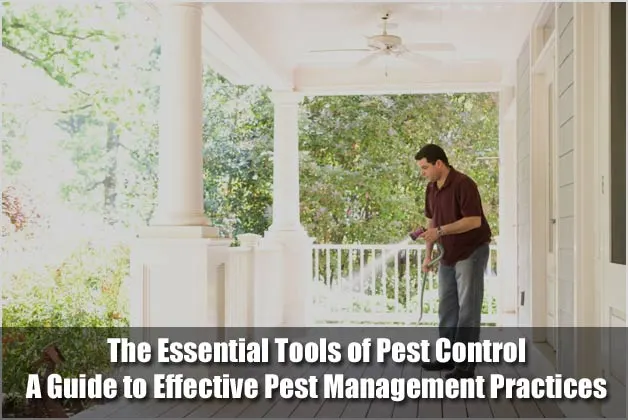What are the effective pest management practices? It is necessary to keep pests under control as part of general house care, and doing so properly requires using the appropriate instruments. In this post, we will talk about some of the methods recommended by experts in pest control, like toplinepestcontrol.co.uk, that can be used as pest management practices and how they work to get rid of and prevent infestations.
- Pesticides. Chemicals called pesticides are used to eradicate or manage pests. They are available as sprays, dust, granules, and baits, among other forms. Pesticides are designed to be effective against a particular insect or set of pests. While some pesticides operate through ingestion or absorption, others are engineered to kill bugs immediately upon touch. Therefore, the use of pesticides must be done very cautiously, and it is crucial to adhere to all label directions.
- Traps and physical barriers. Pests, particularly rodents, are captured and eradicated using traps. Traps come in various forms, such as snap, glue, and live traps. Rodents are intended to be promptly killed by snap traps, while they are captured alive by glue traps and live traps. Traps must be set up where pests are likely to be discovered, such as beneath furniture, along walls, and in shadowy corners. Traps need to be examined often and properly disposed of. On the other hand, screens and caulking act as physical barriers to keep insects out of the house. They prevent insects and rodents from entering the house through tiny cracks and holes.
- Insecticides. Insecticides are used to eliminate insects like ants, cockroaches, and bedbugs. They may come in the form of sprays, baits, and dust. They kill insects by interfering with their nervous system directly on touch or by ingestion. Some insecticides are developed to kill bugs gradually for days or weeks.
- Ultrasonic insect repellent. High-frequency sound waves released by ultrasonic pest repellers are intended to deter pests like mice, rats, and insects. These sound waves may not be perceptible to humans, but they are thought to disturb pests causing them to flee. In addition, they do not use traps or chemicals and are easy to use.
- Foggers. Foggers are tools that spray an insecticide mist into the air to kill pests, such as flies, cockroaches, and mosquitoes. They are used to quickly eliminate pests in big areas, like warehouses or outdoor spaces. They can be dangerous if not used properly, so you should read the labels and adhere to the directions. Foggers could also leave behind a residue that is dangerous to people and animals.
- Dust spreaders. Insecticide dust is applied using dust applicators to places like cracks and crevices where bugs are likely to be located. The dust adheres to the bugs’ bodies, rendering them inedible or lethal upon touch. Dust applicators are frequently utilised for difficult-to-reach places where conventional pest management instruments would not work.
While utilising the proper pest control tools, several non-chemical strategies exist to prevent and control infestations. These methods can be highly beneficial for those concerned about the potential impacts of pesticide use on their health and the environment.
- Integrated pest management or IPM. This combines several chemical-free pest control techniques. To lessen the incidence of pest infestations, IPM employs a variety of techniques, including sanitation, habitat modification, and biological treatments.
- Sanitation. This is the practice of keeping a dwelling tidy and clutter-free to ward against pest infestation. Examples of this include regularly vacuuming, doing the dishes right away, and storing food in sealed containers. Changing the environment to make it less enticing to pests is known as habitat modification. Caulking cracks and crevices, repairing leaky pipes, and keeping plants away from the house are a few examples of how to do this.
- Biological control. It uses natural predators or parasites to suppress pest populations. For instance, using nematodes can help manage grubs in grass, while introducing ladybugs or lacewings to a garden can help manage aphids.
Did you know that many plants naturally produce compounds that can repel or deter pests? Some plants emit volatile organic compounds that act as natural insect repellents, while others have chemicals that are toxic or unpalatable to pests. Find out now if one of the most popular interior decoration plants, amydrium medium silver, has any pest control benefits.
Conclusion
For pest control to be successful, the appropriate pest control practices and equipment must be used, including combining tactics appropriate for the specific pest issue and the ecosystem in which it occurs. It’s important to use these instruments sensibly and pay close attention to the directions on their label. Maintaining proper hygiene habits, such as keeping your house neat, blocking access points, and frequently disposing of waste, is equally important to employing pest control products. As such, homeowners can keep their homes free of pests while reducing the risks to their health and the environment.

I love all things tech, and I wear many hats – tech lover, business starter, digital marketer, and blogger. I know the ins and outs of Digital Marketing, SEO, SEM, SMM, and how to generate leads. My goal? Making things simple for you with clear guides and reviews. I stumbled upon WordPress while creating my first business site, and I fell in love with it right away. When I’m not building websites, creating content, or boosting clients’ online efforts, I’m focused on staying healthy, hanging out with family, and exploring the world. Connect with me on Facebook, Twitter, Linkedin, or read my complete biography.

